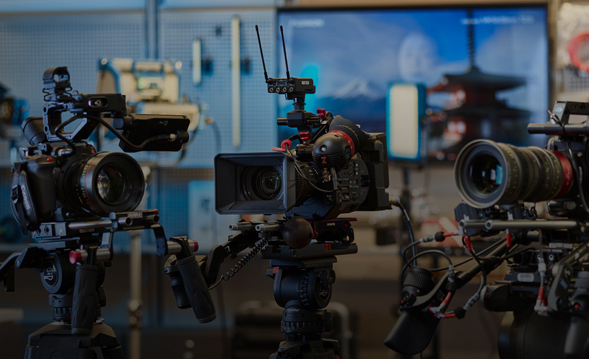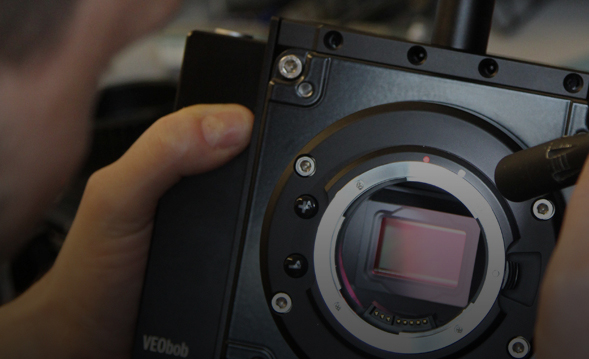Overview
The Canon EOS C300 Mark III is a customizable digital cinema camera designed for versatility, flexibility, usability, and raw imaging power. The lightweight body is equipped with Canon's new Super 35mm Dual Gain Output (DGO) sensor, capable of over 16 stops of dynamic range.
Canon Super 35mm Dual Gain Output (DGO) Sensor
The DGO Sensor imaging system generates high dynamic range (HDR) and maintains low noise levels by reading out each pixel with different gains. It combines images using pixels shot with a saturation-prioritizing amplifier for bright areas and a lower-noise noise-prioritizing amplifier for darker areas.
DIG!C DV7 Image Processor
The EOS C300 Mark III features Canon's DIG!C DV7 image processor, which takes the extensive RAW information captured from the imaging sensor and processes it for output. DiG!C is also the engine behind features such as high frame rate recording, Dual Gain Output (DGO) Sensor, Dual Pixel Autofocus, internal Cinema RAW Light Recording, HDR (PQ) output, Electronic Image Stabilization, and proxy recording.
- Recording Format: Cinema RAW Light XF-AVC
- Sensor Modes:
- Super 35mm
- Recording Resolutions (120 fps max.):
- 4K (4096x2160)
- UHD (3840x2160)
- 2K (2040x1080)
- Full HD (1920x1080)
- Recording Resolutions (120 fps max.):
- Super 16mm
- Recording Resolutions (180 fps max.):
- 2K (2040x1080)
- Full HD (1920x1080)
- Recording Resolutions (180 fps max.):
- Super 35mm
- Sensor Modes:
Canon Cinema RAW Light & XF-AVC Recording
Thanks to the powerful DIG!C DV7 image processing platform, the EOS C300 Mark III can record Cinema RAW Light directly to onboard CFexpress cards. Cinema RAW Light offers plenty of freedom for grading with a dynamic range that can exceed 16 stops with Dual Gain Output (DGO) technology, while maintaining file sizes that are about 1/3 to 1/5 the size of Canon Cinema RAW. Canon Cinema RAW Light offers a great combination of codec efficiency and quality.
In addition to the conventional Intra-based XF-AVC codecs, Canon has added a 4:2:2 10 bit Long GOP-based codec with consideration for a balance of quality and data rates. This new Long GOP-based codec has a data rate that is less than half that of the conventional Intra codecs. This new lightweight codec makes it easier for users to reduce media costs and work with cloud-based infrastructures.
The EOS C300 Mark III Digital Cinema Camera incorporates the new Canon XF-AVC codec that allows 4K and 2K image data to be recorded internally onto CFexpress cards in workflow efficient file sizes using advanced video compression. Using the XF-AVC codec, the EOS C300 Mark III can record a variety of frame fates up to 4K 120p and 2K up to 180fps.
Canon Log 2 & 3
The EOS C300 Mark III supports both Canon Log 2 and Canon Log 3 Gamma. In post-production, Canon Log is designed to reproduce the entire tonal range that the CMOS image sensor is capable of. Log workflows provide the user with higher dynamic range, more highlight and shadow retention, and more flexibility in grading.
Canon Log 2 provides the largest dynamic range and image detail. While Canon Log 2 provides the most post-production flexibility and full dynamic range of the sensor, it typically requires more time in color correction.
For users looking for most of the benefits of log workflow, but with shorter turnaround times, Canon Log 3 provides an alternative with only a slightly reduced dynamic range of 14 stops.
4K 120p High Frame Rate Recording
The EOS C300 Mark III is capable of ultra-high frame rates with its new chip design and DiG!C DV7 processor. Frames rate up to 120 fps can be obtained in 4K, while 2K CROP mode provides even greater flexibility with speeds up to 180 fps.
Proxy Recording
Higher resolution, greater bit depths and faster frame rates provide versatility and greater image quality but come at the cost of much larger file sizes. Proxy files can greatly speed up the editorial process by providing a lower bandwidth alternative for initial file sharing and rough cutting. Canon's powerful, high-speed DIGIC DV7 image processor makes it possible for the EOS C300 Mark III to simultaneously record 2K Proxy files. Cinema RAW Light can be recorded to the internal CFexpress card while an XF-AVC 2K 4:2:0 8-bit Proxy can be recorded directly to an internal SD card. Then C300 Mark III can also apply LUTs to Proxy recording.
Modular Design with Optional Expansion Units & Lens Mounts
The EOS C300 Mark III is the ideal expression of form and function, adaptable to virtually any production thanks to its modular design. Three expansion units and easy user interchangeability between EF, Locking EF (EF-C) and PL mounts allow the EOS C300 Mark III camera to be set up in a variety of configurations for a broad range of production applications. Users can choose the desired look and lens for their project without a costly and inconvenient mount change.
NOTE: The EOS C300 Mark III ships with an EF Mount unless otherwise specified. A B4 mount adapter is also available (sold separately). Each mount swaps easily by simply removing four M3 hex screws. A shim set is provided with each mount kit in order to adjust back focus for the precision in focusing accuracy.*
*Depending on the mount the user has in place. Mounts need to be both swapped and shimmed correctly.
Anamorphic Lens Support
The EOS C300 Mark III offers cinematographers support for the use of both 2.0 and 1.33 anamorphic lens types. Users can achieve the wide cinematic looks, oval bokeh, and striking flares particular to anamorphic glass. It is a distinctly cinematic palette that is within reach for your next project.
Electronic Image Stabilization
The EOS C300 Mark III includes the same built-in five-axis electronic IS introduced with the EOS C500 Mark II that works with almost any lens, including anamorphic.
Dual Pixel CMOS Autofocus with support for Touch AF and Face Detection
The Cinema EOS C300 Mark III features Canon's Dual Pixel CMOS AF Technology. For DAF, each pixel in the camera's CMOS sensor is configured with two photodiodes. Two independent image signals can then be detected at each photosite and compared using phase-difference to provide autofocus with compatible lenses. DAF can survey the scene and recognizes not only whether the subject is in focus or not, but in which direction (near or far), and by how much. DAF also powers the intuitive Focus Guide for users who prefer to focus manually but enjoy the positive feedback DAF provides through the guide interface.
LM-V2 4.3" LCD Touch Screen Monitor
The LM-V2 4.3” LCD Monitor is an easy to view touch panel with approximately 2.76 million dots. The monitor easily attaches to the EOS C300 Mark III using included accessories and can be adjusted to different viewing positions. The LCD monitor is capable of displaying both image framing and visual confirmation of camera settings. Additionally, the display has a control interfaced to make it easy to access and change camera settings.
Support for Custom User LUTs
Users can upload and apply custom LUTs to the EOS C300 Mark III. LUTs can be assigned to specific output terminals, LCD and viewfinder. Clients can be viewing one LUT, while production works from another, giving different production roles the ability to customize the look of the image to their needs.
12G SDI
With 12G SDI support, the EOS C300 Mark III can output 4K resolution up to 60p over a single BNC cable.
RC-V100 Support & LANC Compatible
The EOS C300 Mark III body has a remote A terminal (LANC) on the body and supports remote B (RS422) in both expansion unit EU-V1 and EU-V2. Through these connectors, the EOS C300 Mark III can be completely remote operated either by a standard LANC compatible cable or over longer distances through the use of a serial connection.
Features:
- Canon Super 35mm Dual Gain Output (DGO) Sensor
- DIGIC DV 7 Image Processor
- Modular Design with Three Available Expansion Units
- Canon Log 2 & 3 Gamma Support
- LM-V2 4.3" LCD Touch Screen Monitor
- 4-channel Audio Recording
- Support for Custom User LUTs
- User Interchangeable Lens Mounts (EF Mount included)
- Anamorphic Lens Support
- Canon Cinema RAW Light and XF-AVC Recording
- Five-axis Electronic Image Stabilization
- 12G-SDI
- Dual Pixel CMOS AF with Touch AF and Face Detection
Specifications:
Video Formats
- Cinema RAW Light:
- Resolution: 4096 x 2160, 2048 x 1080, 10 bit (59.94P/50.00P), 12 bit (29.97P/23.98P/ 25.00P/24.00P)
- Bit Rate: 1Gbps/250Mbps
- XF-AVC (Intra-frame recording):
- Resolution / Color Sampling: 4096 x 2160 YCC422 10 bit, 3840 x 2160 YCC422 10 bit, 2048 x 1080 YCC422 10 bit, 1920 x 1080 YCC422 10 bit, 2048 x 1080 RGB444 12 bit/10 bit, 1920 x 1080 RGB444 12 bit/10 bit
- Bit Rate: 810/410/310/225/ 210/160Mbps
- XF-AVC (Long GOP recording):
- Resolution / Color Sampling: 4096 x 2160 YCC422 10 bit, 3840 x 2160 YCC422 10 bit, 2048 x 1080 YCC422 10 bit, 1920 x 1080 YCC422 10 bit, 1280 x 720 YCC422 10 bit
- Bit Rate: 260/160/50/24Mbps
- XF-AVC (Long GOP Proxy recording):
- Resolution / Color Sampling: 2048 x 1080 YCC420 8 bit, 1920 x 1080 YCC420 8 bit, 1280 x 720 YCC420 8 bit
- Bit Rate: 35/24/17Mbps
Related/Compatible Accessories (Sold Separately)
- Remote Controller RC-V100
- Tripod base TB-1
- Wireless Transmitter
- GPS Receiver GP-E2
- Unit Cable UN-10
- OLED Electronic View Finder EVF-V50/EVF-V70
- Expansion Unit 1: EU-V1
- Expansion Unit 2: EU-V2
- EF Cinema Lock Mount Kit CM-V1
- PL Mount Kit PM-V1
- B4 Mount Adapter MO-4E/MO-4P
- LCD Monitor LM-V1
- LCD Attachment Unit LA-V1
- Shoulder Support Unit SU-15
- Shoulder Style Grip Unit SG-1
- Clamp Base CL-V2
- Rod Clamp RD-1
- Handle Unit HDU-2
- 8-pin Remote Cable RR-10/RR-100
What's in the Box
- M4 Screw for Microphone Holder Unit
- Microphone Holder Unit
- Thumbrest
- Bolt Stopper
- M3 Hex Socket Head Bolt
- 1/4" Hex Socket Head Bolt
- M4 Hex Wrench
- M3 Hex Wrench
- 1/4" Hex Wrench
- Canon UN-5 Unit Cable
- Extension Unit Attachment Bracket
- Canon BP-A60 Battery Pack
- Power Cord
- AC Power Cable
- Compact Power Adapter CA-CP200 B
- Battery Charger CG-A20
- SS-1200 Shoulder Strap
- Handle Unit
- Canon LA-V2 LCD Attachment Unit
- Canon LM-V2 4.3" LCD Monitor
- Canon GR-V1 Camera Grip
- Canon EOS C300 Mark III Camera Body
Specifications
Key Highlights
- 35mm Dual Gain Output (DGO) sensor
- 4K 120 fps HFR Recording
- EF Mount
- 16+ stops of dynamic range
- Internal Cinema Raw Light Recording
- Dual Pixel Autofocus
- Electronic Image Stabilization
- HDR (PQ) output
























